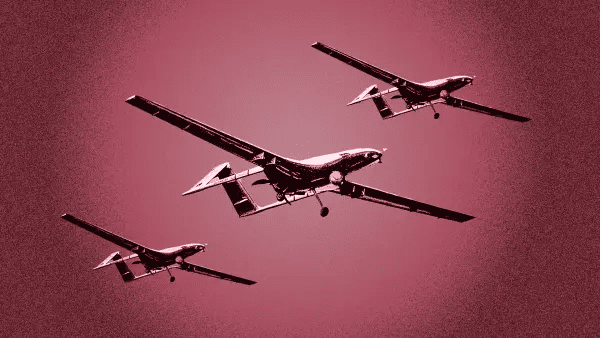By Fred Harter
The Ethiopian Orthodox priest reached the site of the explosion just minutes after the missile had hit. It was a scene of complete devastation.“It was horrific,” he told The New Humanitarian. “The place was littered with body parts of dead people, intact dead bodies, and survivors with missing limbs who were moaning in pain.”
The target on 19 February in Ethiopia’s restive Amhara region was an Isuzu truck transporting dozens of civilians, the priest and another witness said. The attack was carried out by a military drone that had been hovering over the area, they added.
The second witness, called Belaw, lost nine members of his family in the strike. They were returning from a baptism ceremony. Belaw helped remove 16 dead bodies from the site, including relatives. He estimates that over 30 people were killed and many more wounded.
“On the day of the attack, life was normal, with people going about their day-to-day business,” said Belaw. “We were not expecting the tragedy that happened in the afternoon. There hadn’t been any fighting in the area.”
Drone attacks like the one that killed Belaw’s relatives have become a hallmark of the counterinsurgency campaign aimed at quashing a rebellion that erupted in Amhara, Ethiopia’s second-biggest region, at the end of July.In the first days of the rebellion, militiamen known as Fano launched a surprise assault from the countryside to seize control of Amhara’s towns and airports. The military only managed to regain control by deploying tanks and artillery.
Since then, Fano forces have retreated to Amhara’s mountainous interior, but they continue to launch raids on towns to steal weapons and release prisoners from police stations. The military, which has scant control over the countryside, appears to be increasingly turning to its fleet of drones to counter them.
‘State-of-the-art weapons’
This arsenal includes Iranian and Chinese drones, but it is Türkiye’s Bayraktar TB2 that Ethiopia has come to rely on most, analysts say. The model is robust, costs a fraction of the US Predator drone, and is easy to operate and maintain. Foreign dignitaries got a rare glimpse of these weapons at a joint Ethiopian-Emirati air show on 16 December at Ethiopia’s main air base of Harar Meda, close to the capital, Addis Ababa.
A Western official who attended told The New Humanitarian he counted at least five Turkish and four Chinese drones in the back of a hangar. They requested anonymity so they could speak freely. During the event, the chief of Ethiopia’s military, General Birhanu Jula, presented an award to the CEO of Baykar, the Turkish company that makes the Bayraktar drones. And in a sign that the country could be expanding its fleet, Ethiopian Prime Minister Abiy Ahmed inaugurated a new drone hangar.
“These are state-of-the-art weapons,” said the Western official. “It is the highest type of military technology not even possessed by most European militaries.”
Yet their use in Ethiopia reflects their proliferation across the world. Drones have shaped battlefields from Libya to Ukraine to Armenia in recent years. Burkina Faso, Nigeria, and Mali are also using them extensively against jihadist insurgents – with similar dismay that targeting does not properly discriminate between civilians and combatants.
A catalogue of civilian casualties
There is mounting concern about the civilian toll in Ethiopia, where drones are being used to put down regional revolts. On 10 December, six days before the Harar Meda air show, drone strikes hit targets in and around the town of Amhara Sayint, in the Amhara region’s South Wollo zone, according to two residents.
Like the missile strike that killed Belaw’s family members, one of the attacks hit a truck carrying dozens of people. “There were dozens of dead people and human blood splattered everywhere,” a resident who visited the scene told The New Humanitarian.
He described seeing the drone hovering above the town in the hour leading up to the strike. Another witness said the truck was transporting ordinary civilians as well as “Fano supporting youths” who were taking food to militia fighters.
Another strike, also against a truck, killed dozens of civilians in August last year in the Amhara town of Finote Selam. Both the UN and the state-appointed Ethiopian Human Rights Commission have documented other drone strikes in the region, including an attack against a school and another on a bus stop.
The deployment of drones in Amhara mirrors their use in Oromia, Ethiopia’s biggest state, where regional and federal security forces have been battling ethno-nationalist militants from the Oromo Liberation Army (OLA) since 2018.
Drones have become an integral part of the military’s efforts against the group, which tends to operate in remote areas that are difficult for soldiers to access.
In one of the bloodiest strikes, at least nearly 70 people were killed in a village in Oromia’s West Shewa district in October 2022, according to local media.
More recently, on 25 December, a suspected drone attack hit the grounds of a church in the Horo Guduru Welega zone of Oromia, killing eight people and injuring five others as they collected corn, Reuters reported.
Most strikes go unreported
In both regions, most strikes go unreported, according to two Western officials, who also spoke on the condition of anonymity. “It’s very difficult to get reliable information,” said one. “We get reports of schools being hit, whereas the Ethiopian government says they are only targeting specific military targets.”
In December, army chief Birhanu Jula made a rare admission about Ethiopia’s use of drones, but he denied they targeted civilians. “Drones are built for war. They are built for battle. We bought them to fight with, not to publicise we have drones in the media,” he told a state broadcaster.
Warning people not to “mix with the extremists and to keep their children at home”, he added: “We take action when we identify extremists gathered in one place. We will continue, without targeting civilians.” Birhanu also said there had been several occasions when the military had identified militants but refrained from striking them because civilians were nearby.
Yet human rights experts say Ethiopia is using drones indiscriminately and in remote places where there is little oversight.“It’s extremely important that drone attacks are heavily monitored and investigated, but we also need to see credible steps towards justice and accountability for all forms of attacks against civilians.”
Suad Nur, a campaigner with Amnesty International, said the Ethiopian military’s use of drones is part of a broader pattern of impunity that characterises conflicts in the country. Nur noted that government troops have been accused of extra-judicial killings, beatings, and looting in Amhara, Oromia, Tigray, and elsewhere in Ethiopia.
“It’s extremely important that drone attacks are heavily monitored and investigated, but we also need to see credible steps towards justice and accountability for all forms of attacks against civilians,” Nur told The New Humanitarian.
Last year, the work of the UN’s human rights commission on Ethiopia was allowed to lapse after no country tabled a proposal to extend its mandate at the UN’s Human Rights Council in October. The body, set up during the 2020-2022 Tigray war, was the only independent probe investigating abuses in Ethiopia.
Nur said the termination of the investigation meant there were faint hopes for meaningful accountability. “It’s extremely disappointing that the international community is not doing enough on the justice front,” she said.
Drones were first used extensively in Ethiopia during the Tigray war. They were particularly instrumental in repelling the advance of rebel Tigray forces on Addis Ababa in late 2021, when they were used to hit targets, direct artillery strikes, and feed intelligence to ground troops.
Former rebel fighters who participated in the advance towards Addis Ababa and the subsequent withdrawal to Tigray described hearing the constant buzz of drones in the skies as they retreated on foot. In a letter to UN Secretary-General António Guterres, Tigray’s leader at the time, Debretsion Gebremichael, wrote that the region’s forces were pummelled by “drones provided by foreign powers”.
‘This is not a viable strategy’
Drone strikes killed hundreds of civilians throughout 2021 and 2022 in Tigray. One strike, on 7 February 2022, killed at least 59 people at a displacement camp in the region. In Oromia and Amhara, the risk of hitting civilians is arguably greater. The Tigray rebels had heavy weapons such as tanks, and resembled a conventional military force, whereas Fano and OLA militants are loosely organised and only carry AK-47 rifles, making them harder to distinguish from civilians.
As in Pakistan, Yemen, and Somalia, where the United States has used drones strikes extensively against insurgents, analysts are questioning the effectiveness of Ethiopia’s drone wars. They note the rebellions in Amhara and Oromia have only grown in severity, despite the use of drones.
At the core of both insurgencies are ethno-nationalist grievances about representation in Ethiopia’s federal structure. The OLA claims to be fighting for greater autonomy for the Oromo, Ethiopia’s biggest ethnic group, while the Amhara feel sidelined and threatened by Abiy’s administration.
“This is not a viable strategy to defeat insurgencies,” said Wim Zwijnenburg, an analyst from Dutch NGO PAX who has documented Ethiopia’s drone fleet. “In the short term, you can take out fighters and leaders, but in the long term you can’t just whack-a-mole your way out of an ideological war with drone strikes.”
This article was first published on the New Humanitarian:

